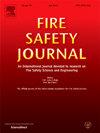Study on the suppression of hydrogen-air explosions by ultrafine water mist containing KCl, K2CO3, or NaCl
IF 3.4
3区 工程技术
Q2 ENGINEERING, CIVIL
引用次数: 0
Abstract
Hydrogen explosions pose significant risks in industrial applications due to their highly reactive and flammable nature. While most existing studies have focused on water mist (WM) with additives to suppress deflagrations in hydrocarbon combustion, research on hydrogen explosions remains limited. This work aims to address these gaps by investigating the effects of different WM concentrations (600 g/m3-2400 g/m3), alkali metal salt additives (KCl, K2CO3, NaCl), and alkali metal salt concentrations (2.5%, 5%, and 7.5%) on hydrogen explosions across varying hydrogen concentrations (20%–40%) in a vented vessel. Key findings reveal that 5% KCl mist exhibits a better suppression efficiency. Increased mist concentration effectively reduces both flame propagation velocity and explosion pressure. When the hydrogen concentrations are 20% and 35%, with a 5% KCl mist concentration of 2400 g/m3, the maximum explosion overpressure decreased by 60.48% and 40.02% respectively, compared to no suppressant. The suppression mechanism was inferred to involve a combination of physical effects (heat absorption and dilution) and chemical interactions (formation of KOH). These results provide valuable insights into optimizing explosion suppression strategies for hydrogen explosions in the process industry.
含KCl、K2CO3、NaCl的超细水雾对氢空气爆炸的抑制研究
氢爆炸由于其高度反应性和可燃性,在工业应用中构成重大风险。虽然现有的研究大多集中在水雾(WM)中添加添加剂来抑制碳氢化合物燃烧中的爆燃,但对氢爆炸的研究仍然有限。本研究旨在通过研究不同WM浓度(600 g/m3-2400 g/m3)、碱金属盐添加剂(KCl、K2CO3、NaCl)和碱金属盐浓度(2.5%、5%和7.5%)对通风容器中不同氢浓度(20%-40%)下氢爆炸的影响来解决这些空白。主要研究结果表明,5%的氯化钾雾具有更好的抑制效果。雾浓度的增加有效地降低了火焰传播速度和爆炸压力。氢气浓度为20%和35%时,5%氯化钾雾浓度为2400 g/m3时,最大爆炸超压分别比无抑制剂时降低了60.48%和40.02%。据推测,抑制机制涉及物理效应(吸热和稀释)和化学相互作用(形成KOH)的结合。这些结果为优化过程工业中氢爆炸的爆炸抑制策略提供了有价值的见解。
本文章由计算机程序翻译,如有差异,请以英文原文为准。
求助全文
约1分钟内获得全文
求助全文
来源期刊

Fire Safety Journal
工程技术-材料科学:综合
CiteScore
5.70
自引率
9.70%
发文量
153
审稿时长
60 days
期刊介绍:
Fire Safety Journal is the leading publication dealing with all aspects of fire safety engineering. Its scope is purposefully wide, as it is deemed important to encourage papers from all sources within this multidisciplinary subject, thus providing a forum for its further development as a distinct engineering discipline. This is an essential step towards gaining a status equal to that enjoyed by the other engineering disciplines.
 求助内容:
求助内容: 应助结果提醒方式:
应助结果提醒方式:


